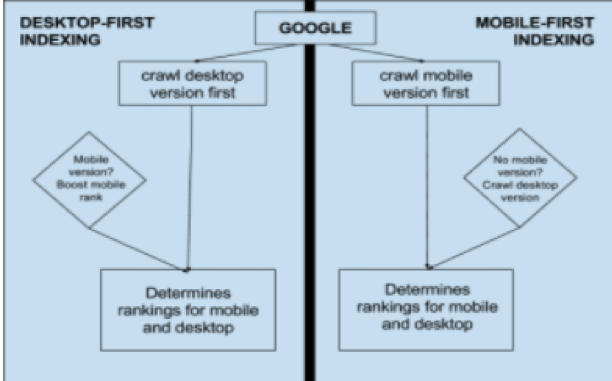Did you know that Google is switching to a mobile-first index next year? This article consolidates everything you need to know—based on what Google has told us (so far).
Google first announced it was “experimenting” with mobile-first indexing on its Official Google Webmaster Blog back in 2016. Since then they’ve released additional information on how it’s going to work and what we can do to prepare.
Here is what we know so far:
#1 The Mobile-First Index is NOT a separate index
This is something that as an SEO Agency we are well aware of, but something that is not widely understood in those who are not in that world.
There will not be a separate mobile-first index and a separate desktop index. Instead, the mobile version of your website will be used for indexing and ranking purposes—rather than the desktop version.
Google is doing this on a URL basis, so if you have a separate desktop and mobile URL for your website, they’ll show the desktop URL to desktop users and the mobile URL to mobile users—but the indexed content will be the mobile version.

#2 You cannot “opt-out” of Mobile-First Indexing
Google started rolling out Mobile-First indexing at the end of 2017, slowly, and by March 2018 they announced they were expanding this rollout further.
However, it seems to have been a longer process than they were expecting as from the date of this post, not all websites have been enabled for mobile-first indexing (nearly 4 years later)!
If your site hasn’t been moved over yet, you need to be patient, as there’s nothing you (or we) can do to make this process quicker. We can’t opt you out of it either.
#3 Google bases its decision on a number of factors
When it comes to deciding how ready your website is for mobile-first indexing, Google looks at a number of things including:
- Content – is it optimised for mobile (easy to read on a small screen)?
- Links – are they quality links?
- Images – have they been optimised for mobile?
- Videos – have they been optimised for mobile?
- Structured Data – is it installed correctly on your site?
- Metadata
Google has also warned website owners that if you use a lot of JavaScript on your website this may prevent it from being moved over to mobile-first indexing.
#4 Mobile-first indexing will be applied to new websites by default
If you have a website that was published after 1st July 2019 then it’ll be mobile-first indexed by default—as Google announced in May 2019. They also announced that this change would be applied to any website that was previously unknown to Google Search.
The “Mobile-First Indexing by default for new domains” announcement also went on to explain that Google had made the decision to make mobile-first indexing the default for new websites as they believed that new websites “are typically ready for this type of crawling”.
#5 Your website should provide the same experience on mobile AND desktop
Google updated its mobile-first indexing best practices earlier this year (2020) in order to place even more emphasis on the fact that your website should present an identical experience on both mobile and desktop.
In summary, this means:
- The Googlebot should be able to access and render all mobile and desktop page content and resources
- Your mobile site should contain the same content as your desktop site
- Both your mobile and desktop site should have the same meta robots tags
- Having the same headings on both your mobile and desktop site
- Making sure both your mobile and desktop site have the same structured data
There’s a myth going around that your mobile site should have less content on than your desktop site—this is not the case. In fact, Google has warned that you may see drops in rankings if your mobile pages have less content than your desktop pages. This is because if Google can’t get the same information from your mobile site as it did your desktop site, it won’t send traffic there.
#6 Mobile-first Indexing and Mobile Usability are two different things
Mobile Usability and mobile-first indexing are two completely different things—according to Google.
Your site will be added to mobile-first indexing if your text can be displayed on a mobile device and that text can be crawled by Google. So, even if your website is not considered usable on a mobile device, it may still contain all of the content needed for mobile-first indexing.
#7 Your website should take into account Google’s “best practices”
As we’ve mentioned before, Google has published a list of best practices for mobile-first indexing—and so you need to be aware of what these are and make sure your mobile (and desktop) sites adhere to them.
- Users should have the same experience on your mobile and desktop site
- Google should be able to see lazy-loaded content
- Google should be able to crawl all resources
- Metadata should be the same on both sites
- Any Ads you run should not cause a bad mobile user experience (ie. Pop-ups)
- Your mobile site should contain high-quality images
- Images and videos should be in a supported format
- The same alt text should be used on both sites
- Video and image URLs should stay the same every time the page loads on a mobile site
- Videos should be easy to find and view on your mobile site
As you can see, mobile-first indexing is going to have an impact on SEO, content marketing and website design, with Google releasing an increasing amount of information all the time.
We’re busy helping our clients ensure that they’re successfully prepared for when Google’s Mobile-First Index goes live. If you’d like us to ensure you’re prepared too, then please get in touch with us today.
Google’s Mobile-First Index: What Does it Mean for SEO?
Digital SEO Web Design and Development / Oct 19, 2020
Did you know that Google is switching to a mobile-first index next year? This article consolidates everything you need to know—based on what Google has told us (so far).
Google first announced it was “experimenting” with mobile-first indexing on its Official Google Webmaster Blog back in 2016. Since then they’ve released additional information on how it’s going to work and what we can do to prepare.
Here is what we know so far:
#1 The Mobile-First Index is NOT a separate index
This is something that as an SEO Agency we are well aware of, but something that is not widely understood in those who are not in that world.
There will not be a separate mobile-first index and a separate desktop index. Instead, the mobile version of your website will be used for indexing and ranking purposes—rather than the desktop version.
Google is doing this on a URL basis, so if you have a separate desktop and mobile URL for your website, they’ll show the desktop URL to desktop users and the mobile URL to mobile users—but the indexed content will be the mobile version.

#2 You cannot “opt-out” of Mobile-First Indexing
Google started rolling out Mobile-First indexing at the end of 2017, slowly, and by March 2018 they announced they were expanding this rollout further.
However, it seems to have been a longer process than they were expecting as from the date of this post, not all websites have been enabled for mobile-first indexing (nearly 4 years later)!
If your site hasn’t been moved over yet, you need to be patient, as there’s nothing you (or we) can do to make this process quicker. We can’t opt you out of it either.
#3 Google bases its decision on a number of factors
When it comes to deciding how ready your website is for mobile-first indexing, Google looks at a number of things including:
- Content – is it optimised for mobile (easy to read on a small screen)?
- Links – are they quality links?
- Images – have they been optimised for mobile?
- Videos – have they been optimised for mobile?
- Structured Data – is it installed correctly on your site?
- Metadata
Google has also warned website owners that if you use a lot of JavaScript on your website this may prevent it from being moved over to mobile-first indexing.
#4 Mobile-first indexing will be applied to new websites by default
If you have a website that was published after 1st July 2019 then it’ll be mobile-first indexed by default—as Google announced in May 2019. They also announced that this change would be applied to any website that was previously unknown to Google Search.
The “Mobile-First Indexing by default for new domains” announcement also went on to explain that Google had made the decision to make mobile-first indexing the default for new websites as they believed that new websites “are typically ready for this type of crawling”.
#5 Your website should provide the same experience on mobile AND desktop
Google updated its mobile-first indexing best practices earlier this year (2020) in order to place even more emphasis on the fact that your website should present an identical experience on both mobile and desktop.
In summary, this means:
- The Googlebot should be able to access and render all mobile and desktop page content and resources
- Your mobile site should contain the same content as your desktop site
- Both your mobile and desktop site should have the same meta robots tags
- Having the same headings on both your mobile and desktop site
- Making sure both your mobile and desktop site have the same structured data
There’s a myth going around that your mobile site should have less content on than your desktop site—this is not the case. In fact, Google has warned that you may see drops in rankings if your mobile pages have less content than your desktop pages. This is because if Google can’t get the same information from your mobile site as it did your desktop site, it won’t send traffic there.
#6 Mobile-first Indexing and Mobile Usability are two different things
Mobile Usability and mobile-first indexing are two completely different things—according to Google.
Your site will be added to mobile-first indexing if your text can be displayed on a mobile device and that text can be crawled by Google. So, even if your website is not considered usable on a mobile device, it may still contain all of the content needed for mobile-first indexing.
#7 Your website should take into account Google’s “best practices”
As we’ve mentioned before, Google has published a list of best practices for mobile-first indexing—and so you need to be aware of what these are and make sure your mobile (and desktop) sites adhere to them.
- Users should have the same experience on your mobile and desktop site
- Google should be able to see lazy-loaded content
- Google should be able to crawl all resources
- Metadata should be the same on both sites
- Any Ads you run should not cause a bad mobile user experience (ie. Pop-ups)
- Your mobile site should contain high-quality images
- Images and videos should be in a supported format
- The same alt text should be used on both sites
- Video and image URLs should stay the same every time the page loads on a mobile site
- Videos should be easy to find and view on your mobile site
As you can see, mobile-first indexing is going to have an impact on SEO, content marketing and website design, with Google releasing an increasing amount of information all the time.
We’re busy helping our clients ensure that they’re successfully prepared for when Google’s Mobile-First Index goes live. If you’d like us to ensure you’re prepared too, then please get in touch with us today.
Array
